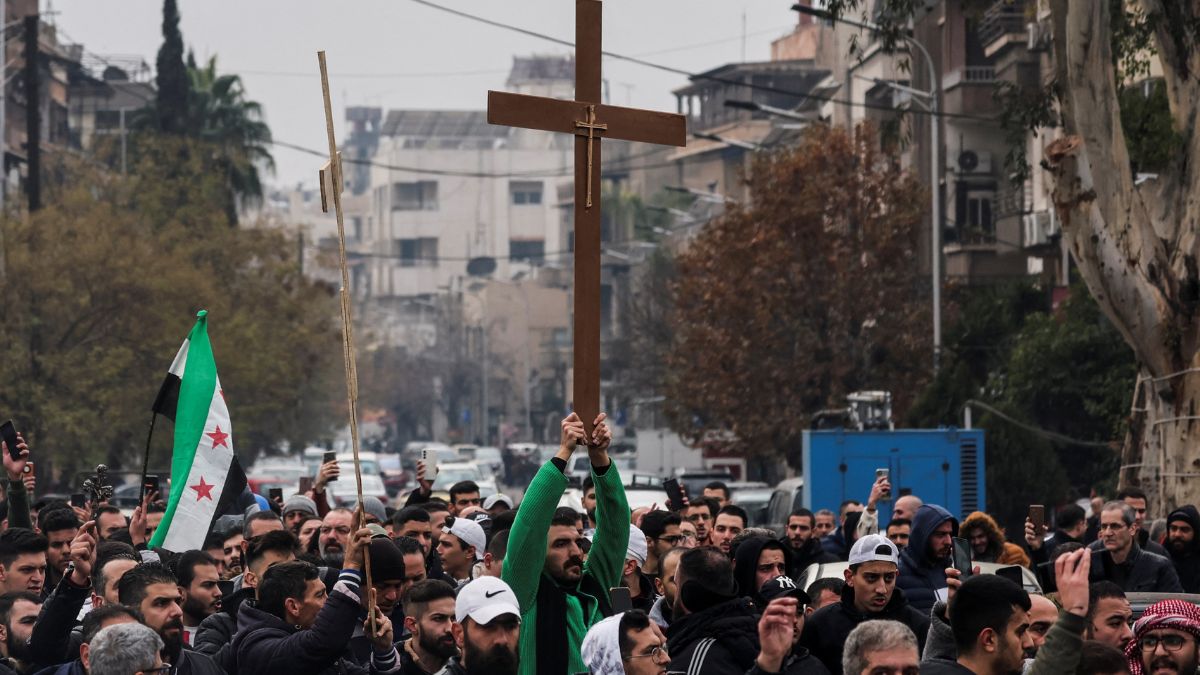Thousands of Syrians took to streets —hundreds of them in capital Damascus— in protest against the burning of a Christmas tree.
After a video showing masked gunmen setting fire to a Christmas tree in the Christian-majority town of Suqaylabiyah, near Hamas in central Syria, people took to streets in protests. The outrage prompted the country’s new rulers, the Hayat Tahrir al-Sham (HTS), in action. The HTS claimed that the perpetrators have been arrested and assured the public that the tree would be repaired before Christmas.
As the international community as well as minority communities within Syria are demanding an inclusive administration, how HTS goes about governing Syria would decide whether the population is placated or is triggered into another round of internal conflict. There are doubts whether the HTS can deliver on the expectations as it remains an Islamist authoritarian group at best and a jihadist group at worst .
After the video of the burning of Christmas tree went viral, the HTS was quick to dissociate itself from the act. It said that the perpetrators were foreign fighters.
The protests in several parts of Syria were not just against the arson just before Christmas, but were also a display of a fundamental demand for the new rulers — the protection of religious and ethnic minorities.
In the Bab Touma neighbourhood of Damascus, demonstrators carrying cross and Syrian flags chanted “we will sacrifice our souls for our cross”, according to BBC.
A demonstrator who gave his name as Georges told AFP: “If we’re not allowed to live our Christian faith in our country, as we used to, then we don’t belong here anymore.”
Impact Shorts
More ShortsThe episode highlights the contradictions of Syria, which currently stands at crossroads. While much of Syria was joined in the opposition to the dictatorial rule of the Assad dynasty, the religious and ethnic faultlines are now coming to the fore.
Moreover, the conflict with Bashar al-Assad was largely political over his dictatorial rule and not along religious or ethnic lines. The Assads were secular and belong to a minority Shia Alawite sect in a Sunni-majority Syria.
As per the US Department of State, 74 per cent of Syrians are Sunni Muslims from various ethnicities, such as Arabs, Kurds, Circassians, Chechens, and Turkmen. Other Muslim groups such as Alawites, Ismailis, and Shia, comprise 13 per cent of the population Druze are around 3 per cent of the population. Christians comprise around 10 per cent of the population.
In place of secular Assad dynasty, Syria is now controlled by HTS, an outright Islamist authoritarian group which was formally the Syrian branch of Al Qaeda till 2016. Even though the HTS and its leader, Abu Mohammad al-Jolani, say they have given up their terrorist ways, the world is not convinced. Jolani started out as an Islamic State terrorist and switched to Al Qaeda later to start HTS as Al Qaeda’s branch in Syria.
While the HTS’ public relations overdrive of recent years would give the impression that it is a liberal group, there are signs that even if the group had given up its jihadist ways —and that is a very big if— the group still remains an Islamist authoritarian group and it is not a secular group. The experience of Idlib, which the HTS has governed since 2017, shows that religious minorities have a complicated relationship with the group.
Journalist Wassim Nasr, who has visited Idlib, told France 24 that even though he witnessed freedom of religion in the province, it was limited.
Nasr said that there was no public display of Christian crosses or ringing of church bells.
Such a treatment suggests that even though the HTS is not like the Islamic State (IS), it has not given up its hardcore Islamist roots and has not yet allowed adequate religious freedoms to its subjects.


)

)
)
)
)
)
)
)
)



